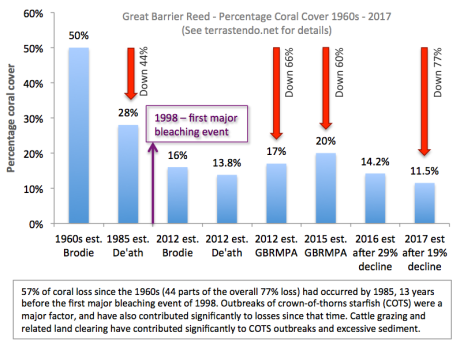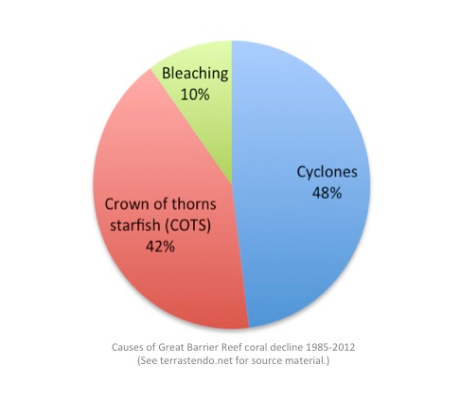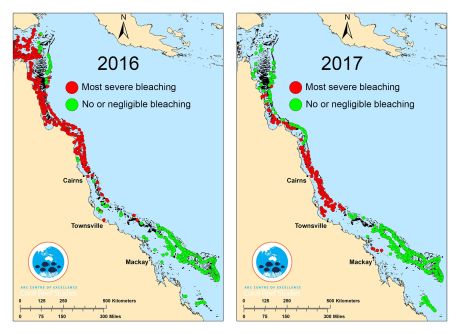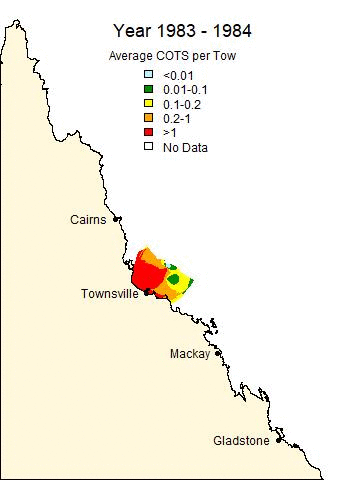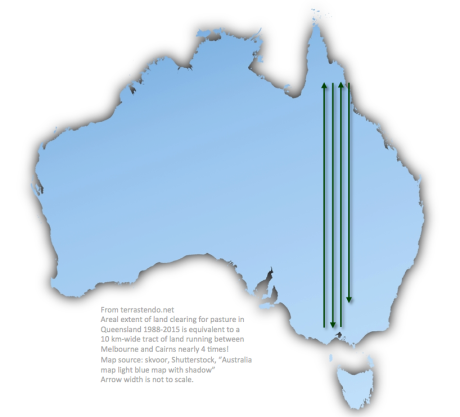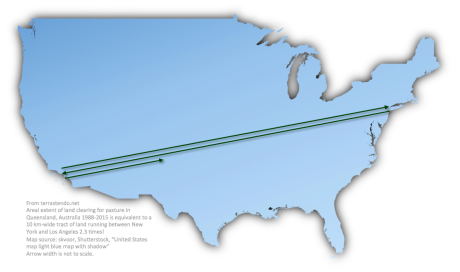It appears we may be witnessing the tragic demise of one of the world’s natural wonders, the Great Barrier Reef (GBR). The process has justifiably been covered extensively by media outlets around the world, with much of the coverage focusing on coral bleaching, primarily caused by warming seas. However, has that been the main cause of coral loss?
It may surprise some to find that, until the past two years at least, the answer had been a resounding “no”. This article comments on the other causes. It also asks why environmental groups who campaign vigorously against the use of fossil fuels have said nothing meaningful about those other factors.
A major contributing factor has been erosion from livestock grazing (including related tree clearing), which releases sediment and nutrients (nitrogen and phosphorus) to the GBR waters via nearby streams and rivers. The sediment inhibits coral growth and promotes the excessive development of algae, while the nutrients contribute to outbreaks of crown-of-thorns starfish, which have had a devastating impact.
Before considering those issues in detail, let’s look at the extent to which live coral cover on the reef has declined.
EXTENT OF LIVE CORAL COVER
Let’s take the 1960s as the baseline period. Professor Jon Brodie from the Australian Research Council Centre of Excellence for Coral Reef Studies at James Cook University has reported that coral covered around 50 per cent of the reef at that time, compared to around 16 per cent in 2012. [1] The change represented a decline in coral extent of 68 per cent.
Estimates vary, and soon after Professor Brodie’s figure was published, Dr Glenn De’ath and fellow researchers from the Australian Institute of Marine Science (AIMS) and the University of Wollongong estimated that the extent of coral cover around the same time was only 13.8 per cent, representing a decline of 72.4 per cent (again assuming 50 per cent as the base coverage extent). [2]
The Great Barrier Reef Marine Park Authority (GBRMPA) has estimated a minimum figure of 17 per cent, followed by some recovery between 2012 and 2015, with an increase to 20 per cent. [3] On that basis, the decline from the 1960’s to 2012 (assuming that was the minimum) would have been 66 per cent, and to 2015, 60 per cent.
Two mass bleaching events in 2016 and 2017, along with other factors as referred to below, have caused further declines in live coral cover. In mid-2016, the GBRMPA’s interim assessment of the 2016 bleaching event indicated that 22 per cent of coral had died. It has since increased the estimate to 29 per cent. [4]
Although the latter figure related to shallow water corals, the authority has said:
“Coral bleaching did extend to deeper corals beyond depths divers typically survey to, but mortality cannot be systematically assessed. . . . In 2017, further coral loss is expected from the second consecutive year of bleaching and the impacts of tropical cyclone Debbie. . . . A complete picture for 2017 won’t be available until early next year.”
Professor Terry Hughes, Director of the ARC Centre of Excellence for Coral Reef Studies, indicated on 21st May 2017 that the figure for 2017 is 19 per cent. [5] [Footnote 1]
If we assume that the figure of 29 per cent for 2016 applied to all GBR corals, and that the figure of 19 per cent for 2017 will be confirmed, the current extent of live coral cover (before allowing for declines caused by other factors over the past two years) would be around 11.5 per cent.
It seems reasonable to assume that estimates of percentage reductions are based on the extent of coverage that existed at the beginning of the period being assessed. If so, they are calculated on what has generally been a declining base.
On that basis, the decline from bleaching in 2016 and 2017 (to date) would equate to 17 per cent of the 1960s coverage, which is far less than indicated in much of the relevant media coverage, which indicated that around half had been lost. [6] The figures are represented in Figure 1. [Footnote 2]
The total reduction for the period from the 1960s to 2017, as represented here, is 77 per cent, with coverage of 11.5 per cent (2017) as a proportion of 50 per cent (1960s) being 23 per cent. [See update of 9 July 2017 below, along with more details on the causes in the following sections.]
Figure 1(a): Percentage of Coral Cover 1960s – 2017 (updated 25 July 2017)
Figure 1(b): Pre and Post 1985 Coral Loss (added 25 July 2017)

Ominous warnings have been issued in the recent past, including the following comment from AIMS and University of Wollongong researchers in 2012, as referred to earlier:
” . . . coral cover on the GBR is consistently declining, and without intervention, it will likely fall to 5–10 per cent within the next 10 years.”
CAUSES OF CORAL DECLINE
In researching the causes of coral decline between 1985 and 2012, Dr Glenn De’ath and his co-authors (referred to earlier) assessed the relative contributions of tropical cyclones, crown-of-thorns starfish (COTS) and coral bleaching. Their results are shown in Figure 2.
Figure 2: Causes of GBR coral decline 1985 – 2012
In a profound indication of the relative impact of COTS predation, the researchers estimated that there would have been a net increase in average coral cover if such predation had not occurred, rather than their estimated reduction of 50.7 per cent.
Findings from Kate Osborne and fellow AIMS researchers in 2011 indicated there was no overall loss for the period 1995-2009, with loss in some areas and species offset by expansion in others. [7] However, in respect of those corals that did decline, they reported COTS as the major cause at 36.7 per cent compared to cyclones at 33.8 per cent, disease at 6.5 per cent, bleaching at 5.6 per cent, with the remainder comprising multiple or unknown causes.
Jon Brodie reported in 2012 that COTS were probably the major cause of coral mortality in the period from 1960 to 1985, but pointed out that available data for the period was incomplete. [8]
Water quality has also been a major factor, as it affects the frequency of COTS outbreaks in the central and southern GBR.
CORAL BLEACHING
Many types of coral have a symbiotic relationship with marine algae known as zooxanthellae that live inside their tissue. The zooxanthellae are efficient food producers that provide up to 90 per cent of the energy corals require to grow and reproduce. They also give coral much of its colour. [9] [10]
When the relationship becomes stressed due to factors such as ocean temperature or pollution, the zooxanthellae leave the coral’s tissue. Without the zooxanthellae, the tissue of the coral animal appears transparent and its bright white skeleton is revealed.
Without the zooxanthellae as a food source, corals generally begin to starve.
If conditions return to normal, corals can regain their zooxanthellae, return to their normal colour and survive. However, this stress is likely to cause decreased coral growth and reproduction, and increased susceptibility to disease. Bleached corals often die if the stress persists.
Rising sea temperature is the main cause of coral bleaching. Other stressors can also contribute to it but generally to a smaller extent. They include: tropical cyclones; freshwater inflows from flooding events (with low salinity); sedimentation; pollution from urban or agricultural run-off; over-exposure to sunlight; and disease. [11] [12]
Major bleaching events have occurred on the GBR in 1998, 2002, 2016 and 2017.
Reefs can often recover from such events if given enough time, but two in quick succession in 2016 and 2017 may have caused permanent loss of large sections of the reef. The images in Figure 3, from the Australian Research Council Centre of Excellence for Coral Reef Studies, highlight the degree of impact of those two events.
Figure 3: Coral Bleaching Events 2016 and 2017
There is no doubt that coral bleaching is a critical, perhaps catastrophic, issue. Although De’ath et. al. highlighted the need to improve water quality and develop relevant control measures, they stressed that such measures would only succeed if climatic conditions were stabilised, as losses from bleaching and cyclones will otherwise increase.
As a result, given the lack of meaningful response from so-called world leaders to the climate change threat, and taking into account the impact of other stressors that have destroyed much of the reef and weakened the resilience of much of the remaining coral, we may have lost the opportunity to save the reef. [13]
CROWN-OF-THORNS STARFISH (COTS)
COTS are marine invertebrates that occur naturally on reefs throughout the Indo-Pacific region, feeding exclusively on coral. Certain conditions enable them to reach plague proportions and devastate hard coral communities.
Figure 4: Crown-of-thorns starfish devouring coral off northern Queensland
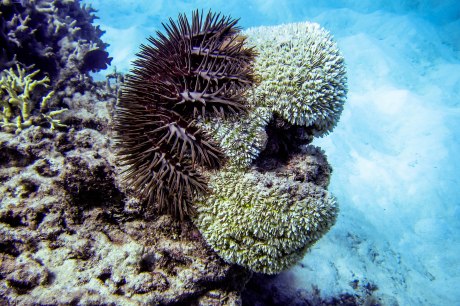
Crown-of-Thorns Starfish (Acanthaster planci), Lizard Island (Ryan McMinds, Flickr)
The long-term monitoring program conducted by AIMS has shown that outbreaks have begun in the north and migrated southward, generally over periods of around 15 years, with ocean currents transporting larvae between reefs. There have been four major outbreaks on the Great Barrier Reef since the 1960s: in that decade itself; the late 1970s; the early 1990s; and 2010 (which is still under way). [14]
De’ath et. al. have reported that COTS were likely to have occurred every 50-80 years before European agricultural nutrient runoff commenced.
Healthy reefs generally recover between outbreaks, taking 10 to 20 years to do so. However, recovery takes longer on reefs that are affected by additional stresses, such as coral bleaching, cyclones or poor water quality, so the coral may not fully recover before the next wave of outbreaks occurs. [15]
Jon Brodie has stated “it is now well established” that the major COTS outbreaks since 1962 were most likely caused by nutrient enrichment associated with increased discharge of nitrogen and phosphorus from the land due to soil erosion and large scale fertiliser use. The nutrients promote phytoplankton growth suitable to COTS larvae. [16]
The impact of livestock production within the reef’s catchment area is particularly relevant to the water quality issue (including sediment and nutrient discharge), as referred to later in this article.
Fishing also appears to be a major factor in relation to COTS outbreaks. In the mid-shelf region of the GBR, where most outbreaks occur, the frequency of outbreaks as of 2008 on reefs that were open to fishing had been 3.75 times higher than on those where it was prohibited. Although exploited fish species are unlikely to prey on COTS directly, changes in interactions between species at different positions in the food web may be the cause. [17]
These short videos from AIMS and Stanford University help us to better appreciate the extent of the COTS problem. The Stanford researchers state (with my underline):
“Low numbers of this starfish increase reef diversity, but large numbers can destroy reefs. Avoiding human activities that increase starfish numbers is more effective than trying to control Crown-of-Thorns outbreaks once they happen.”
Video 1: Australian Institute of Marine Science (Duration 1:23):
Video 2: Standford University (Duration 2:29)
Figure 5 shows the location, severity and areal extent of COTS outbreaks between 1982 and 2015. [18]
Figure 5: COTS outbreaks 1982 – 2015 (Animation)
THE IMPACT OF LIVESTOCK PRODUCTION
AIMS has highlighted the fact that deterioration in coastal water quality has negatively affected the function, productivity and resilience of tropical marine ecosystems.
They have reported that the main coastal and marine water quality issues in northern Australia are: (a) increasing sediment, nutrients and contaminants entering coastal waters in runoff from agricultural, industrial and urban land uses (increasing five to nine fold from pre-European settlement); and (b) rising seawater temperatures and increasing seawater acidity associated with climate change. [19]
Livestock production within the reef’s catchment has been a major factor in the release of sediment and nutrients. Eroded material, including nutrients, enters streams and rivers and is then carried to the coast, and from there to the Great Barrier Reef.
The Queensland Government’s 2013 Scientific Consensus Statement confirmed that grazing landscapes, primarily in the Fitzroy and Burdekin catchments, were responsible for 75 per cent of sediment, 54 per cent of phosphorous and 40 per cent of nitrogen in the reef’s waters. [20]
The Great Barrier Reef Marine Park Authority has expressed its concern: [21]
“Most sediment entering the Great Barrier Reef comes from catchments in major pastoral areas such as the Burdekin, Herbert and Fitzroy rivers.”
“Changes in water quality affect the biodiversity and resilience of Reef systems. Higher concentrations of pollutants, such as suspended sediments, nitrogen and phosphorus, indicated by higher levels of chlorophyll and lower water clarity, leader [sic] to more algae and less coral diversity. In these conditions, algae take over and reduce the chances for new hard corals to establish and grow.”
Queensland has been Australia’s main beef production state since around 1885. [22] Trees have been extensively cleared to establish grazing areas, with the level of activity increasing after World War 2 when the technique of dragging a massive chain, linked to two bulldozers, was introduced. (The Wilderness Society has credited the innovation to a young Joh Bjelke-Petersen, who eventually became Queensland’s longest-serving premier.)
For many decades, farmers were required to clear the land as a condition of their government lease, with economic development being the driver. [23]
The Queensland government’s State Landcover and Trees Study (SLATS) has shown that, between 1988 and 2015, 90,340 square kilometres of land were cleared or re-cleared for pasture in Queensland, which is equivalent to nearly 11 million rugby fields (or nearly 17 million American football fields), with the process accelerating in recent years after a partial ban on broadscale clearing was lifted in 2013. [24] [25] [Footnote 3]
It is also equivalent to a tract of land 10 kilometres (6 miles) wide running between Melbourne and Cairns nearly four times!
Figure 6: Livestock-related land clearing in Queensland 1988-2015 expressed as 10 km-wide tracts of land equivalent on Australian continent (Arrow width not to scale)
For more context, it is also equivalent to a 10 kilometre wide tract of land running 2.3 times between Los Angeles and New York.
Figure 7: Livestock-related land clearing in Queensland 1988-2015 expressed as 10 km-wide tracts of land equivalent on contiguous states of USA (Arrow width not to scale)
A deleterious outcome of livestock-related land clearing and livestock grazing in cleared and uncleared areas is gully erosion.
The Victorian government has highlighted the role of those activities in gully erosion generally (with my underline): [26]
“Under natural conditions, run-off is moderated by vegetation which generally holds the soil together, protecting it from excessive run-off and direct rainfall.
Excessive clearing, inappropriate land use and compaction of the soil caused by grazing often means the soil is left exposed and unable to absorb excess water. Surface run-off then increases and concentrates in drainage lines, allowing gully erosion to develop in susceptible areas.”
Soils with dispersible subsoils are very common in Queensland and are vulnerable to gully erosion when the shallow layer of relatively stable top soil is disturbed. As water penetrates through early-stage erosion (referred to as rill erosion up to 30 centimetres deep), the subsoil is dispersed, leaving the topsoil unsupported. The topsoil then collapses and the process is repeated.
From that stage, even with little or no surface flow, the gully walls can become saturated, causing them to slump and the gully to expand. The Queensland government has likened the process at that point to digging a hole to the depth of the water table at the beach, with the hole expanding as the sides slump away. [27]
The underlying rock will often limit gully depth to around two metres, but they can be as deep as fifteen metres in alluvial and colluvial soils.
Figure 8: Gully erosion on cattle property in northern Queensland
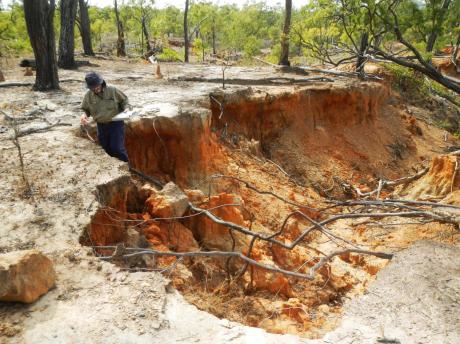
© Griffith University – Andrew Brooks
The following video provides several examples of grazing-related gully erosion in Queensland’s Fitzroy Basin, which has caused massive amounts of sediment to flow to the GBR. Mitigation efforts are highlighted, but to a large extent the damage has been done and is continuing in other areas, with potential to expand elsewhere as more land is cleared for cattle.
The Queensland government’s most recent Reef Water Quality Protection Plan report card scored graziers’ response to the calamity a “D” for “poor”. [28]
In any event, it is estimated that expenditure ranging from $5.3 billion to $18.4 billion (most likely $7.8 billion) would be required to reduce sediment flow by 50 per cent, which is a target established under the Australian and Queensland governments’ Reef 2050 Long-Term Sustainability Plan. [29]
Video 3: Gully erosion in the Fitzroy Basin (Duration 11.55)
Stream bank erosion has also significantly increased sediment discharge to the reef. Here are some thoughts from the Queensland government on that issue (with my underline): [30]
“The major cause of stream bank erosion is the destruction of vegetation on river banks (generally by clearing, overgrazing, cultivation, vehicle traffic up and down banks or fire) and the removal of sand and gravel from the stream bed.”
In commenting on the need to improve water quality, journalist Calla Walqhuist recently indicated in The Guardian that Jon Brodie had recommended a shift from sugar cane production in the reef’s catchment to cattle grazing. [31]
She neglected to say that it is only in the areas where sugarcane is grown that beef grazing would have little impact. Erosion is low in those areas due to high rainfall and extensive vegetation cover, with minimal use of fertilisers and pesticides. Cattle grazing on the large, low rangelands in the Burdekin and Fitzroy catchments, with variable rainfall, is responsible for greatly increased erosion and sediment delivery to the GBR. [32]
Professor Brodie has previously reported that cattle grazing for beef production is the largest single land use in the reef’s catchment area, with cropping (mainly of sugarcane) and urban/residential development “considerably less in areal extent”. [33] As a result, the scope for transitioning from sugarcane production to cattle grazing may be limited.
KEY ENVIRONMENTAL GROUPS EFFECTIVELY IGNORE THE LIVESTOCK ISSUE
The following slideshow includes: Adam Bandt of The Greens political party; Kirsty Albion of Australian Youth Climate Coalition (AYCC); Paul Sinclair of Australian Conservation Foundation (ACF); Charlie Wood of 350.org; and Tim Flannery of Climate Council Australia. [Footnote 4]
What do these people have in common?
One answer is that their organisations have all campaigned to save the Great Barrier Reef from the ravages of climate change and the related activities of coal mining, dredging and shipping, but have ignored or understated: (a) livestock production’s direct reef impacts; and/or (b) livestock production’s climate change impacts. The Greens’ statement on protecting the reef is an example. [34]
To the extent the groups have mentioned COTS outbreaks and water quality issues, they appear to have avoided commenting on the contribution of diet, which is ultimately responsible for livestock production within the reef’s catchment.
How can they and their organisations justify their assumed roles as defenders of the environment, while effectively choosing to ignore such a critical contributor to the ongoing environmental catastrophe?
It is ironic that Tim Flannery implores us to “start talking about the reef”, including around the dinner table, but fails to meaningfully highlight the role of diet in its demise. [35]
I have previously highlighted links between the livestock sector and ACF, AYCC, Climate Council Australia and others. The links include the fact that ACF’s high-tech headquarters in inner Melbourne, in which AYCC and a Greens member of the Victorian parliament are tenants, were donated to it by livestock interests. [36] I am not in a position to comment on the links (details of which are publicly available), other than to say they exist.
Other scientists are ahead of the pack on this issue, leaving Flannery and his Climate Council colleagues in their wake.
Professor Terry Hughes (referred to earlier) and co-authors of a paper that appeared in the June 2017 issue of Nature, have pointed out that scientists have often ignored human behaviour as the ultimate driver of environmental change. [37] For example, they may focus on pollution or climate change, without acknowledging that factors such as human population growth, socio-economic development, and culture and values are the ultimate cause.
Hughes and his co-authors have argued that governments, non-government organisations and social movements “can actively encourage changes in social norms that lead to improved environmental behaviours” through the use of taxes, incentives, subsidies, education and communication. Governments and the groups mentioned here are failing miserably in that regard.
In Australia, criticising the traditional meat-based barbecue may be considered a form of heresy, despite meat consumption being a key factor in the destruction of a global treasure and critical economic asset in the form of the GBR. Indeed, even without climate change, the reef’s demise may have been assured due to decades of relentless sediment and nutrient pollution from grazing and other properties within the reef’s catchment.
Using the phrase “death by a thousand cuts”, the authors also highlighted the need to consider the interaction between multiple factors contributing to the deterioration of coral reefs. They referred to models indicating that “synergistic human impacts can reduce resilience and cause unexpected ecological collapse, even when individual drivers or stressors remain at levels that are considered to be safe”.
Even if we focus solely on climate change, the livestock sector is a key driver. For example, researchers from the Sustainable Society Institute at the University of Melbourne and climate change advocacy group Beyond Zero Emissions (BZE) have estimated that the livestock sector is responsible for around fifty per cent of Australia’s greenhouse gas emissions. [38] The findings were reinforced in a subsequent peer-reviewed journal article, which had two co-authors in common with the BZE paper. [39]
The authors focused on factors that are ignored, under-stated or attributed to non-livestock categories in the national greenhouse gas inventory.
BEEF vs TOURISM
Two-thirds of Australia’s beef was exported in 2012-2013, with the figure likely to have grown since then due to an expansion of the China-Australia Free Trade Agreement (ChAFTA). [40] [41] As a result, modification of diet by the nation’s residents will not be enough to adequately reduce beef production’s negative impacts.
At present, the environmental cost of beef production is not adequately allowed for in the price paid by the end user. Consequently, beef producers are effectively subsidised, while consumers in Australia, China and elsewhere are paying artificially low prices with no effective price signal encouraging them to purchase products with less environmental impact.
The words of CSIRO researcher, Dr Barney Foran, come to mind: [42]
“We should be paying more for products that have a high environmental account balance. The consumer should be expected to pay a realistic price for food so that we play a part in fixing up the bush, instead of sitting in town and wringing our hands about it.”
The current, low-price arrangements may soon come at the expense of the tourism industry as the GBR deteriorates further. In Queensland alone, the industry generates revenues of nearly $23 billion and supports nearly 220,000 jobs directly and indirectly. With 42 per cent of international visitors ranking the reef as the most appealing tourist attraction in Australia, it is also a significant factor in the tourism industry nationally, for which the corresponding figures are $98 billion and 922,000. [43] [44] [45]
By comparison, the beef industry generated less than $18 billion in revenues nationally in 2015/16 (less than tourism in Queensland alone), including $10 billion of exports, with 200,000 people employed (also less than tourism in Queensland), including on-farm production, processing and retail. [46]
CONCLUSION
To the extent that we have any chance of saving the Great Barrier Reef, it is critical that prominent individuals and groups campaigning for that purpose communicate honestly about the factors that are contributing to its parlous state. If it is too late to save it, then we must ask how and why those individuals and groups have failed to address key issues.
It may be easy to feign concern and diligence while conveniently overlooking essential contributing factors, but such abrogation of responsibility will undoubtedly result in catastrophic outcomes unless others can successfully convey the truth to the point that meaningful action is taken.
With that aim in mind, I hope you will help to inform others of the message conveyed in this article.
Author
Footnotes
- Professor Hughes also indicated a figure of 30 per cent for 2016. I have assumed he was rounding up the official figure of 29 per cent, and I have used the latter.
- A reduction in areal extent from 20 per cent to 14.2 per cent represents a reduction of 5.8 percentage points, and from 14.2 per cent to 11.5 per cent a further 2.7 percentage points, i.e. a total of 8.5 percentage points for those two years. The reduction of 8.5 per cent represents 17 per cent of the 1960s coverage, which was 50 per cent of the reef.
Due to their close proximity in terms of timing, it is possible that the 2016 and 2017 declines were both expressed as a percentage of the 2015 areal extent. That approach would accentuate the reduction, leaving 10.4 per cent in 2017 rather than the figure of 11.5 per cent indicated here, and the pre-1985 reduction being 54 per cent rather than 57 per cent. The figures will be amended if my assumptions are found to be incorrect. Either way, they would appear to represent reasonable approximations.
On the other hand, media outlets have reported that half the coral has been lost in the past two years. Clearly, a 50 per cent reduction using the 1960s base figure would not be possible when around 80 per cent of that base figure had already been lost by 2015. - The area represents original clearing and re-clearing, demonstrating the ability of wooded vegetation to regenerate if given the opportunity.
- All photos in the slideshow, other than Tim Flannery’s, are from the “Reef not coal snap action”, held in Melbourne on 5th December, 2016, and arranged by ACF, AYCC and 350.org. Tim Flannery’s image is from a video recorded on the reef, where he spoke solely about climate change.
Updates
9 July 2017:
The GBRMPA has reported that, in addition to bleaching, corals during 2017 have been affected by: (a) tropical cyclone Debbie (late March 2017); (b) subsequent flooding of the Burdekin and Fitzroy Rivers and resultant flood plumes; (c) ongoing outbreaks of coral disease; and (d) crown-of-thorns starfish. [47] Those factors may have resulted in current coral coverage being below 11.5 per cent. Animal agriculture is relevant to each, including: (i) the flood plumes resulting from eroded soils in the Burekin and Fitzroy catchments; and (ii) tropical cyclones which are affected by the sector’s global warming impact.
Even if we attributed all the coral loss in 2016 and 2017 to bleaching (which was not the case), its contribution since the 1960s is likely to have been well below that of cyclones and COTS.
As mentioned within the article, Jon Brodie of the ARC Centre of Excellence for Coral Reef Studies believes COTS were probably the major cause of coral mortality in the period from 1960 to 1985. A major COTS outbreak occurred in the 1960s, while the first major bleaching event occurred in 1998, so bleaching may have had no impact during that period.
5 August 2017:
One paragraph has been amended to clarify the fact that erosion from cattle grazing occurs on uncleared, as well as cleared, land (consistent with many of my previous articles).
References
[1] Brodie, J., “Great Barrier Reef dying beneath its crown of thorns”, The Conversation, 16th April, 2012, http://theconversation.com/great-barrier-reef-dying-beneath-its-crown-of-thorns-6383
[2] , , “The 27–year decline of coral cover on the Great Barrier Reef and its causes”, PNAS 2012 109 (44) 17995-17999; published ahead of print October 1, 2012, doi:10.1073/pnas.1208909109, http://www.pnas.org/citmgr?gca=pnas%3B109%2F44%2F17995
[3] Stella, J., Pears, R., Wachenfeld, D., “Interim Report: 2016 Coral Bleaching Event on the Great Barrier Reef”, Great Barrier Reef Marine Park Authority, September 2016, http://elibrary.gbrmpa.gov.au/jspui/bitstream/11017/3044/5/Interim%20report%20on%202016%20coral%20bleaching%20event%20in%20GBRMP.pdf
[4] Great Barrier Reef Marine Park Authority, Reef Health, 29 May 2017, http://www.gbrmpa.gov.au/media-room/latest-news/coral-bleaching/2017/significant-coral-decline-and-habitat-loss-on-the-great-barrier-reef
[5] Professor Terry Hughes on Twitter, 20th and 21st May 2017, https://twitter.com/ProfTerryHughes/status/866155996078522368
[6] Chang, C. and AAP, “Half the Great Barrier Reef may have died in last two years”, 23 May 2017, http://www.news.com.au/technology/environment/climate-change/half-the-great-barrier-reef-may-have-died-in-last-two-years/news-story/d1a7e2974597f40d04700d7313c9f713
[7] Osborne, K., Dolman, A. M., Burgess, S. C., & Johns, K. A. (2011). Disturbance and the Dynamics of Coral Cover on the Great Barrier Reef (1995–2009). PLoS ONE, 6(3), e17516. http://doi.org/10.1371/journal.pone.0017516, https://www.ncbi.nlm.nih.gov/pmc/articles/PMC3053361/ and https://www.ncbi.nlm.nih.gov/pmc/articles/PMC3053361/pdf/pone.0017516.pdf
[8] Brodie, J., op. cit.
[9] National Oceanic and Atmospheric Administration, National Ocean Service, “What is coral bleaching?”, revised 17 March 2016, http://oceanservice.noaa.gov/facts/coral_bleach.html
[10] Australian Government, Great Barrier Reef Marine Park Authority, “Managing the reef – Coral bleaching” (undated), http://www.gbrmpa.gov.au/managing-the-reef/threats-to-the-reef/climate-change/what-does-this-mean-for-species/corals/what-is-coral-bleaching
[11] Australian Government, Bureau of Meteorology (undated), http://www.bom.gov.au/oceanography/oceantemp/GBR_Coral.shtml
[12] The Nature Conservancy, Ocean and Coasts, “Coral bleaching: What you need to know” (undated), https://www.nature.org/ourinitiatives/habitats/coralreefs/coral-reefs-coral-bleaching-what-you-need-to-know.xml
[13] Dunlop, I., “Time for honesty on climate and energy policy”, The Sydney Morning Herald, 12 December 2016, http://www.smh.com.au/comment/time-for-honesty-on-climate-and-energy-policy-20161208-gt7g1k.html
[14] Great Barrier Reef Marine Park Authority, “History of crown-of-thorns outbreaks on the Great Barrier Reef”, http://www.gbrmpa.gov.au/about-the-reef/animals/crown-of-thorns-starfish/history-of-outbreaks (accessed 11 June 2017)
[15] Australian Institute of Marine Science, “Crown-of-thorns starfish” (undated), http://www.aims.gov.au/docs/research/biodiversity-ecology/threats/cots.html (accessed 11 June 2017)
[16] Brodie, J., op. cit.
[17] Sweatman, H., “No-take reserves protect coral reefs from predatory starfish”, Current Biology, Volume 18, Issue 14, pR598–R599, 22 July 2008, http://www.cell.com/current-biology/fulltext/S0960-9822(08)00671-4 and http://www.cell.com/current-biology/pdf/S0960-9822(08)00671-4.pdf
[18] Australian Institute of Marine Science, “Crown-of-Thorns Starfish distribution” (undated), http://www.aims.gov.au/docs/research/biodiversity-ecology/threats/cots-animation.html (Accessed 11 June 2017)
[19] Australian Institute of Marine Science, “Water Quality” (undated), http://www.aims.gov.au/docs/research/water-quality/water-quality.html
[20] Kroon, F., Turner, R., Smith, R., Warne, M., Hunter, H., Bartley, R., Wilkinson, S., Lewis, S., Waters, D., Caroll, C., 2013 “Scientific Consensus Statement: Sources of sediment, nutrients, pesticides and other pollutants in the Great Barrier Reef Catchment”, Ch. 4, p. 12, The State of Queensland, Reef Water Quality Protection Plan Secretariat, July, 2013, http://www.reefplan.qld.gov.au/about/scientific-consensus-statement/sources-of-pollutants.aspx
[21] Australian Government, Great Barrier Reef Marine Park Authority, “Managing the reef”, undated, http://www.gbrmpa.gov.au/managing-the-reef/threats-to-the-reef/declining-water-quality
[22] May, D., “The North Queensland beef cattle industry: an historical overview“, from Lectures on North Queensland history. No. 4 chapter 6 pp. 121-159, Edited by Dalton, B. J.. Townsville. James Cook University of North Queensland, 1984, http://www.textqueensland.com.au/item/chapter/9b938237e189a1274770d0d2e94209ad
[23] The Wilderness Society, “Land Clearing in Queensland” (undated) https://www.wilderness.org.au/land-clearing-queensland (Accessed 12 June 2017)
[24] Queensland Department of Science, Information Technology and Innovation. 2016. Land cover change in Queensland 2014–15: a Statewide Landcover and Trees Study (SLATS) report. DSITI, Brisbane
[25] Mahony, P., “Beef, the reef and rugby: We have a problem”, Terrastendo, 26 March 2017, https://terrastendo.net/2017/03/26/beef-the-reef-and-rugby-we-have-a-problem/
[26] Agriculture Victoria, “Gully Erosion”, Nov 1999, http://agriculture.vic.gov.au/agriculture/farm-management/soil-and-water/erosion/gully-erosion (Accessed 13 June 2017)
[27] Carey, B., Queensland Government, Natural Resources and Water, “Gully Erosion”, March 2006, https://www.qld.gov.au/dsiti/assets/soil/gully-erosion.pdf
[28] Queensland Government, “Great Barrier Reef Report Card 2015: Reef water quality protection plan”, http://www.reefplan.qld.gov.au/measuring-success/report-cards/2015/ and http://www.reefplan.qld.gov.au/measuring-success/report-cards/2015/assets/gbr-2015report-card.pdf
[29] Australian Government, Department of Environment and Energy, Reef 2050 Long-Term Sustainability Plan – Progress on Implementation Review by Great Barrier Reef Independent Review Group, February 2017, p. 50, http://www.environment.gov.au/marine/gbr/long-term-sustainability-plan
[30] Queensland Government, “Types of erosion”, Last updated 18 December 2013, last reviewed 14 October 2015, https://www.qld.gov.au/environment/land/soil/erosion/types/ (Accessed 13 June 2017)
[31] Wahlquist, C., “Great Barrier Reef: Australia must act urgently on water quality, says Unesco”, The Guardian, 3 June 2017, https://www.theguardian.com/environment/2017/jun/03/great-barrier-reef-australia-must-act-urgently-on-water-quality-says-unesco?CMP=share_btn_fb
[32] Brodie, J., Email correspondence, 9 June 2017
[33] Brodie, J., Christie, C., Devlin, M., Haynes, D., Morris, S., Ramsay, M., Waterhouse, J., and Yorkston, H., “Catchment management and the Great Barrier Reef”, pp. 203 & 205, Water Science and Technology Vol 43 No 9 pp 203–211 © IWA Publishing 200, May 2001, http://wst.iwaponline.com/content/43/9/203
[34] The Greens, “Protecting the Great Barrier Reef” (undated), https://greens.org.au/save-the-reef
[35] The Climate Council of Australia, “Raise the reef”, 13th October 2016, http://www.climatecouncil.org.au/raise-the-reef
[36] Mahony, P., “The link that too many ignore”, Terrastendo, 26 August 2016, https://terrastendo.net/2016/08/26/the-link-that-too-many-ignore/
[37] Hughes, Terry P., Barnes, Michele L., Bellwood, David R., Cinner, Joshua E., Cumming, Graeme S., Jackson, Jeremy B.C., Kleypas, Joanie, van de Leemput, Ingrid A., Lough, Janice M., Morrison, Tiffany H., Palumbi, Stephen R., van Nes, Egbert H., Scheffer, Marten, “Coral reefs in the Anthropocene”, Nature, 546, 82–90, 1 June 2017 (published online 31 May 2017), doi:10.1038/nature22901, http://dx.doi.org/10.1038/nature22901
[38] Beyond Zero Emissions and Melbourne Sustainable Society Institute of The University of Melbourne, “Zero Carbon Australia – Land Use: Agriculture and Forestry – Discussion Paper”, October, 2014, http://bze.org.au/landuse
[39] Wedderburn-Bisshop, G., Longmire, A., Rickards, L., “Neglected Transformational Responses: Implications of Excluding Short Lived Emissions and Near Term Projections in Greenhouse Gas Accounting”, International Journal of Climate Change: Impacts and Responses, Volume 7, Issue 3, September 2015, pp.11-27. Article: Print (Spiral Bound). Published Online: August 17, 2015, http://ijc.cgpublisher.com/product/pub.185/prod.269
[40] Dept of Agriculture, Fisheries and Forestry, “Australian Food Statistics 2012-13″, Table 2.4, p. 53, http://www.agriculture.gov.au/ag-farm-food/food/publications/afs
[41] Tingle, L., “China trade deal adds $400 million to beef exports”, Australian Financial Review, 24 March 2017, http://www.afr.com/news/politics/china-trade-deal-adds-400-million-to-beef-exports-20170324-gv5qzl
[42] Anon., “Counting the Ecological Cost”, The Canberra Times, 29 May 2005
[43] Australian Government, Austrade, Tourism Research Australia, State Tourism Satellite Accounts 2014-15, https://www.tra.gov.au/tra/2016/research/State-Tourism-Satellite-Accounts_2014-15.html and https://www.tra.gov.au/tra/2016/documents/Economic-Industry/State_summaries.pdf
[44] Australian Government, Department of Environment and Energy, op. cit., p. 52
[45] Farm Weekly, “Australian beef exports hit world top”, 30 April, 2017, http://www.farmweekly.com.au/news/agriculture/livestock/general-news/australian-beef-exports-hit-world-top/2755103.aspx?storypage=0
[46] Meat & Livestock Australia, Beef Fast Facts 2016, https://www.mla.com.au/globalassets/mla-corporate/prices–markets/documents/trends–analysis/fast-facts–maps/mla_beef-fast-facts-2016.pdf
[47] Great Barrier Reef Marine Park Authority, Reef Health, 29 June 2017 (relating to 29 July 2017 update), http://www.gbrmpa.gov.au/about-the-reef/reef-health
Images
Brian Kinney, Wonderful and beautiful underwater world with corals and tropical fish (within Figure 1(b)), Shutterstock
Ryan McMinds, Crown-of-Thorns Starfish (Acanthaster planci), Lizard Island, Flickr, Creative Commons, Attribution 2.0 Generic (CC BY 2.0) http://tinyurl.com/yaswsjes
skvoor, Australia map light blue map with shadow, Shutterstock
skvoor, United States map light blue map with shadow, Shutterstock
Slideshow images (except Tim Flannery): Takver, Photographs by: Julian Meehan, “Reef not coal snap action”, 5th Dec 2016, Flickr, Creative Commons Attribution-ShareAlike 2.0 Generic (CC BY-SA 2.0)
Tim Flannery’s image: The Climate Council of Australia, “Raise the reef”, 13th October 2016, http://www.climatecouncil.org.au/raise-the-reef, Creative Commons attribution 3.0 Australia license (CC By 3.0 AU) (Climate Council reports note that “Climate Council of Australia Ltd copyright material is licensed under the Creative Commons Attribution 3.0 Australia License.”)
All photos in the slideshow, other than Tim Flannery’s, are from the “Reef not coal snap action”, held in Melbourne on 5th Dec 2016, and arranged by Australian Conservation Foundation (ACF), Australian Youth Climate Coalition (AYCC) and 350.org.
Andrew Brooks, Griffith University, Gully erosion at Springvale Station, from “Research leads to Great Barrier Reef Rescue Purchase”, Griffith News, 23 June 2016 (Used with permission), https://app.secure.griffith.edu.au/news/2016/06/23/research-leads-to-great-barrier-reef-rescue-purchase/
ARC Centre of Excellence, Media Release “Two-thirds of Great Barrier Reef hit by back-to-back mass coral bleaching”, 10th April 2017, https://www.coralcoe.org.au/media-releases/two-thirds-of-great-barrier-reef-hit-by-back-to-back-mass-coral-bleaching
Animation (Figure 5)
Australian Institute of Marine Science, “Crown-of-Thorns Starfish distribution” (undated), http://www.aims.gov.au/docs/research/biodiversity-ecology/threats/cots-animation.html (Accessed 11 June 2017)
Videos
Australian Institute of Marine Science, “Crown-of-thorns survey video”, https://www.youtube.com/watch?v=0tcYJ0cAuDU
Stanford University, Microdocs Project, “Crown-of-thorns starfish”, https://www.youtube.com/watch?v=_SpLgzPqCV8
Australian Government and Fitzroy Basis Association, “Gully erosion in the Fitzroy Basin”, https://www.youtube.com/watch?v=nhkFiQR4Axs

